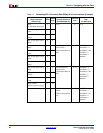
52 www.xilinx.com SPI-4.2 Lite v4.3 User Guide
UG181 June 27, 2008
Chapter 4: Designing with the Core
R
Keep it Registered
The best method to simplify timing and increase system performance in an FPGA design is
to keep everything registered. That is, all inputs and outputs from the user application
should come from, or connect to, a flip-flop. While registering signals may not be possible
for all paths, it simplifies timing analysis and helps you achieve timing closure.
Recognize Timing Critical Signals
Watch the timing and loading on the signals listed below. Some of these signals are part of
the critical timing path. The following list of signals are timing critical and may require
special attention when used in the user application:
• SnkFFRdEn_n
• SrcFFWrEn_n
Use Supported Design Flows
The SPI-4.2 Lite core has been tested with a variety of design flows. While other design
tools can be used to simulate and synthesize your design with the core, their functionality
cannot be guaranteed. See Chapter 7, “Simulating and Implementing the Core” for
information about supported design tools.
Make Only Allowed Modifications
All modifications to the SPI-4.2 Lite core must be made using the Xilinx CORE Generator.
Do not make other modifications as they may have adverse effects on system timing and
SPI-4.2 protocol compliance.
Initializing the SPI-4.2 Lite Core
The SPI-4.2 Lite Sink and Source cores require initialization before receiving and
transmitting data. The initialization steps are:
• Reset core
To reset the cores, the signal Reset_n must be asserted. The reset signal for each core
must remain asserted until the clocks are ready for use.
• Reset DCMs
This step is only applicable if TDClk or RDClk is distributed using global clocking. The
DCMs are only used when the global clocking option is selected. If regional clocking is
selected for all clocks, this step can be skipped. If one or more DCMs are used, you
must reset each DCM in the core while the core is in reset. Reset the DCM by asserting
the DCM reset signal (ex: DCMReset_RDClk). Once the DCM reset is asserted, wait for
the assertion of the DCM locked signal (ex: Locked_RDClk). When the locked signal
is asserted, the clock is ready for use.
See “Sink Clocking Options,” page 111 and “Source Clocking Options,” page 115 for
more information on the regional and global clocking options
• Deassert core reset
Once all the clocks are ready for use, the SnkClksRdy and SrcClksRdy signals will
assert. The Reset_n signal can be deasserted only when these signals are asserted.


















